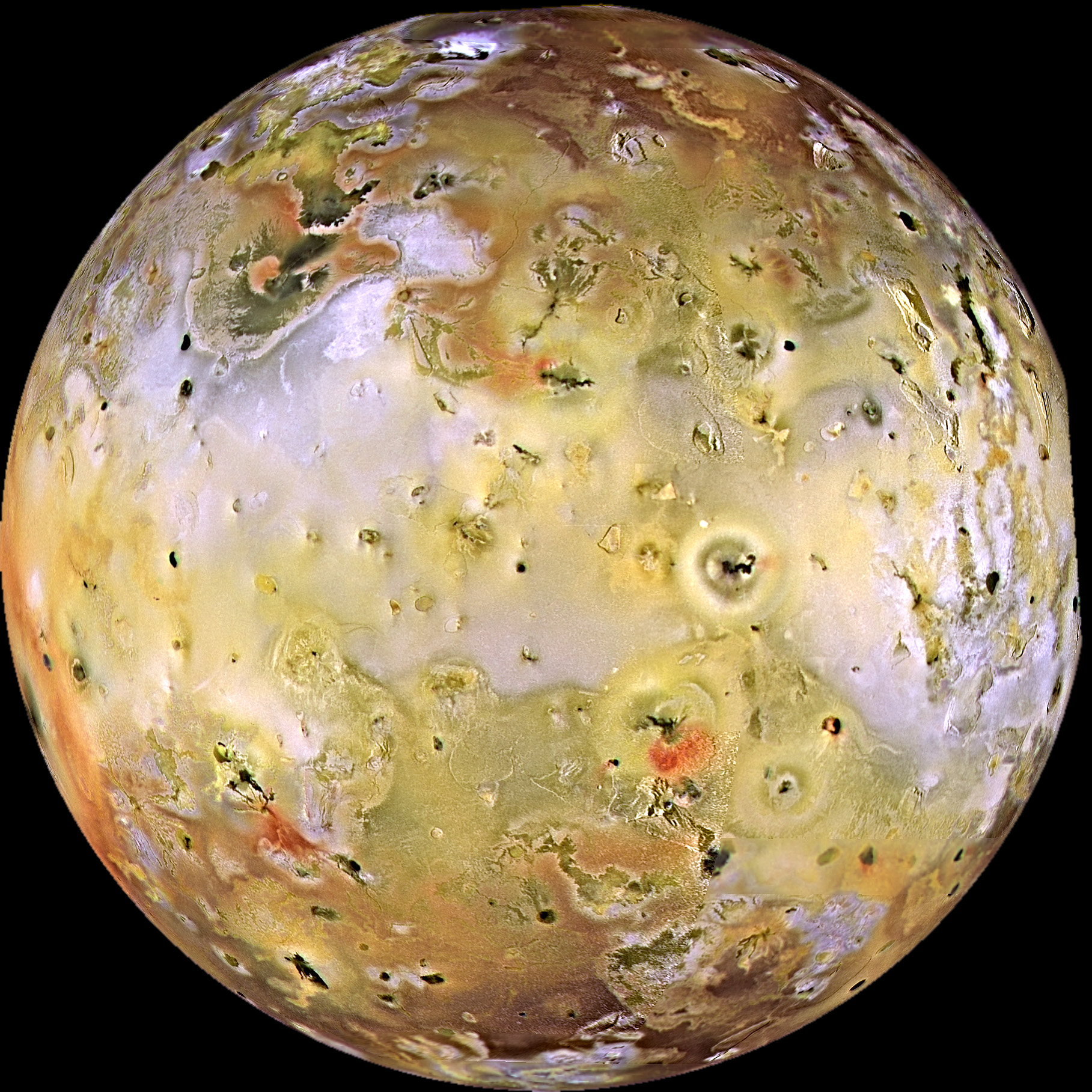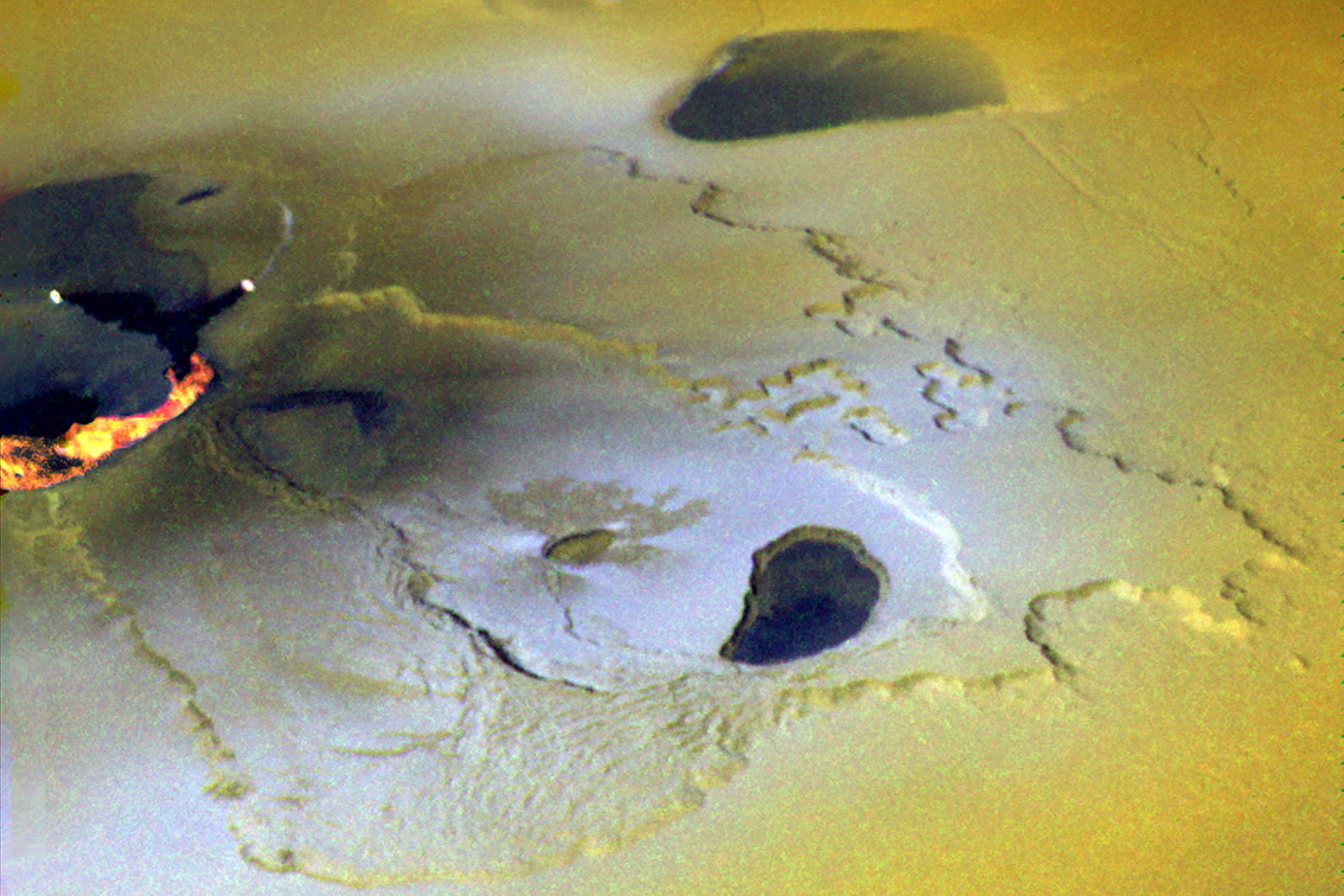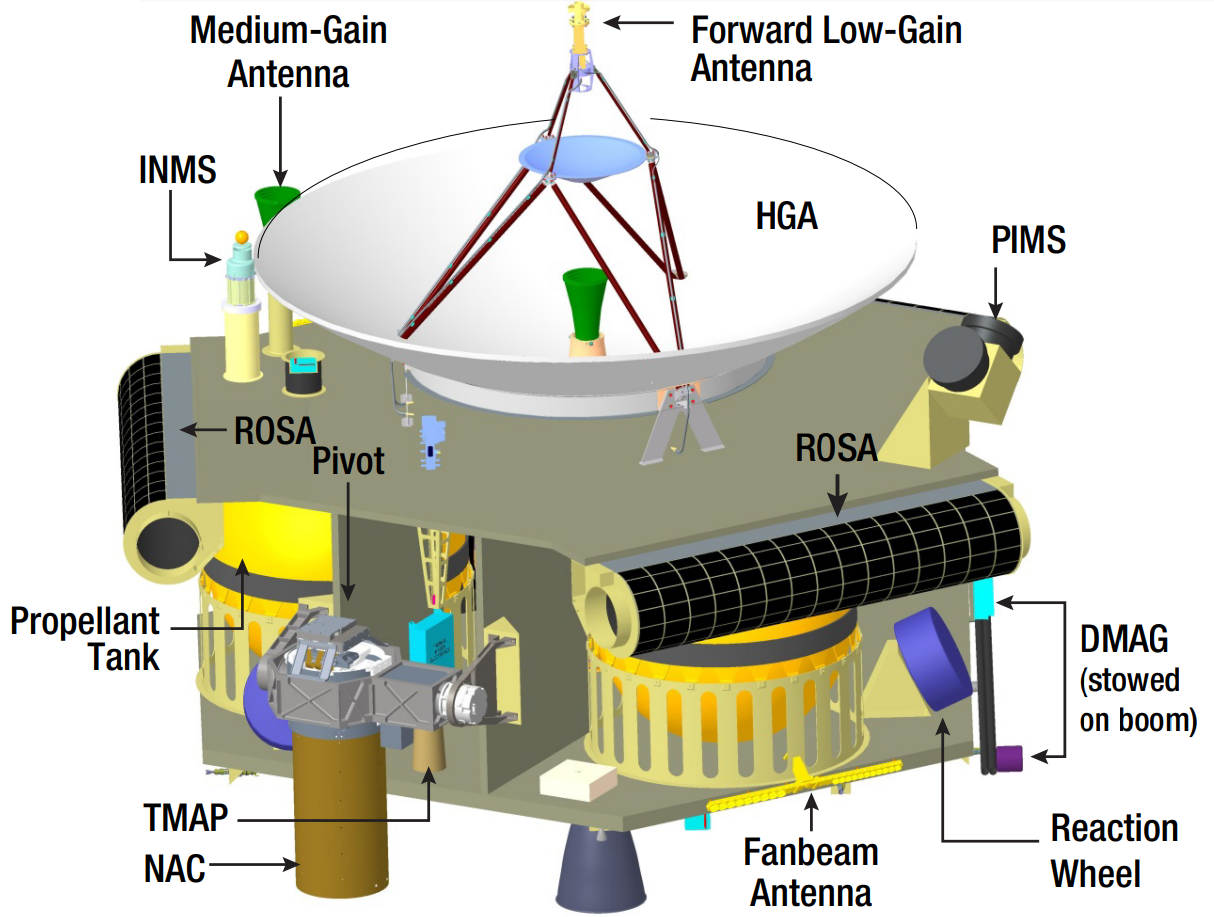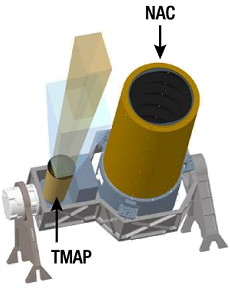| The NASA spacecraft IVO (Io Volcano Observer; pronounced “eye-vee-oh”) was the first candidate mission dedicated to the Jovian moon Io, the most volcanically active world in the Solar system. It was planned to launch in January 2029 and to enter the Jupiter system in August 2033. During ten orbits over 3 years and 11 months, IVO should have made ten close Io flybys at minimum altitudes of ∼300 kilometers. At least six remote-sensing and in-situ science experiments would have investigated multiple aspects of this very dynamic moon. With a mean diameter of 3643 kilometers, Io is just 5 percent larger than our Earth’s moon. In June 2021, IVO has been deselected from further study and flight. | Die NASA-Raumsonde IVO (Io Volcano Observer; gesprochen “ei-wi-ou”) sollte die erste Raumfahrtmission sein, die speziell den Jupitermond Io zum Ziel hat. Io (Durchmesser: 3643 km) ist der vulkanisch aktivste Körper im gesamten Sonnensystem. Der Start sollte im Januar 2029 erfolgen und das Jupitersystem im August 2033 erreicht werden. Während der dann folgenden zehn Jupiterumkreisungen, die 3 Jahre und 11 Monate dauern sollten, hätte IVO zehn nahe Vorbeiflüge an Io in Abständen von zumeist ∼300 Kilometern durchgeführt. Mindestens sechs wissenschaftliche Fernerkundungs- und In-situ-Experimente sollten dabei diesen äußerst dynamischen Mond erforschen. Im Juni 2021 wurden allerdings zwei konkurrierende Missionen ausgewählt, so dass IVO nicht realisiert werden wird. |
The DLR Institute of Planetary Research in Berlin (Germany) was participating in the IVO mission by contributing the Thermal Mapper (TMAP) remote sensing instrument. IVO was a proposal to NASA’s Discovery program; this program has the goal to achieve outstanding scientific results by launching planetary missions which are smaller, cheaper, and more focused, but also more numerous than large missions like Cassini. The final selection for Discovery missions 15 and 16 occured in June 2021. Among the four competitors — a Venus orbiter (VERITAS), a Venus atmosphere probe (DAVINCI+), IVO, and a flyby mission at Neptune’s largest moon Triton (Trident) —, the two Venus missions have been selected.
Fig. (middle): Image mosaic of Io, obtained by the Galileo SSI camera on 07 Sep 1996. The colorization is caused by sulphur, sulphur dioxide, and siliceous compounds.
Fig. (right): Volcanic eruption at Tvashtar Catena (60°N, 120°W on Io), observed by the Galileo spacecraft on 22 Feb 2000. The false-color image was taken in violet, green and near-infrared filters; for the eruption area, IR filters up to a wavelength of 1 µm were used.
This website gives a short overview of some of the numerous interesting aspects of the IVO mission. A reference list with weblinks and scientific papers for more in-depth reading is provided at the last sheet of this page.
Last update: 06 Sep 2023 — page content is best displayed on a computer screen at least 1024 pixels wide
(1) Featured
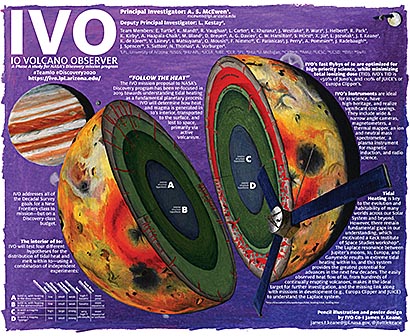 • 02 Jun 2021: NASA announced that the two competitor missions VERITAS and DAVINCI+ have been selected for flight. IVO will not be realized.
• 02 Jun 2021: NASA announced that the two competitor missions VERITAS and DAVINCI+ have been selected for flight. IVO will not be realized.
• 15 Mar 2021: My LPSC (Lunar and Planetary Science Conference) poster about IVO and Irregular moons (ePoster here; conference abstract here)
• 07 Jan 2021: Comprehensive COSPAR 2021 talk by IVO PI Alfred McEwen about the IVO mission (26-min video here)
• 21 Sep 2020: My EPSC (Europlanet Science Congress) talk about the potential of IVO for irregular moons science (10-min video here; conference abstract here)
• 23 Jul 2020: Simulation of the 10 Io flybys of the orbit tour currently used for mission planning → YouTube Video (duration 20:28 min; version 3).
• 21 Apr 2020: About a paper on Io’s and Europa’s influences on the Jupiter system → short review on eos.org.
• March 2020: IVO fact sheet and poster
• 13 Feb 2020: IVO has been selected for Phase-A study → NASA press release → NSPIRES release (pdf file)
• 18 Oct 2019: Alfred McEwen, Katherine de Kleer, and Ryan Park about tidal heating, orbital resonances, and what we will learn from missions like IVO to the outer Solar system → article on eos.org.
(2) DLR participation
TMAP thermal mapper (led by Jörn Helbert)
(3) Mission timeline
With discard of the IVO mission by NASA in June 2021, the information in this sheet is only of historic relevance.
(3A) Cruise and Orbit Tour Table
· Develop and build
· 20 Feb 2020 ff — Prepare final selection round (Phase A)
· Oct 2023 ff — Preliminary design of spacecraft and instruments (Phase B)
· Apr 2025 ff — Detailed design of spacecraft/instruments, prototypes (Phase C)
· Mar 2027 ff — Assemble and test spacecraft and instruments (Phase D)
· Launch and cruise (Phase E)
· Jan 2029 — Launch (earliest: 30 Dec 2028; best: 13 Jan 2029; latest: 24 Jan 2029)
· Jan 2030 — Deep space maneuver (DSM; Δv = 313 … 361 m/s; depends on launch date)
· 25 Feb 2031 — Earth flyby at 4390 km altitude (Moon: ∼½ day earlier at 38550 km)
· 23 May 2031 — Mars flyby at 400 km altitude
· Mar 2032 — Flyby at asteroid (11377) Nye
· Jupiter tour
· 02 Aug 2033 — 1st Io flyby (I1; 310 km altitude); Jupiter orbit insertion (JOI; Δv = 660 m/s)
· 2034 — Io flybys I2 (15 Apr; 308 km); I3 (25 Jul; 301 km); I4 (11 Oct; 305 km)
· 2035 — Io flybys I5 (22 Feb; 302 km); I6 (29 May; 209 km)
· 2036 — Io flybys I7 (13 Feb; 1005 km); I8 (05 Jul; 301 km)
· 2037 — Io flybys I9 (12 Jan; 310 km); I10 (02 Apr; 301 km); Io impact (06 Jul) or extended mission
(3B) Cruise and Orbit Tour Plots
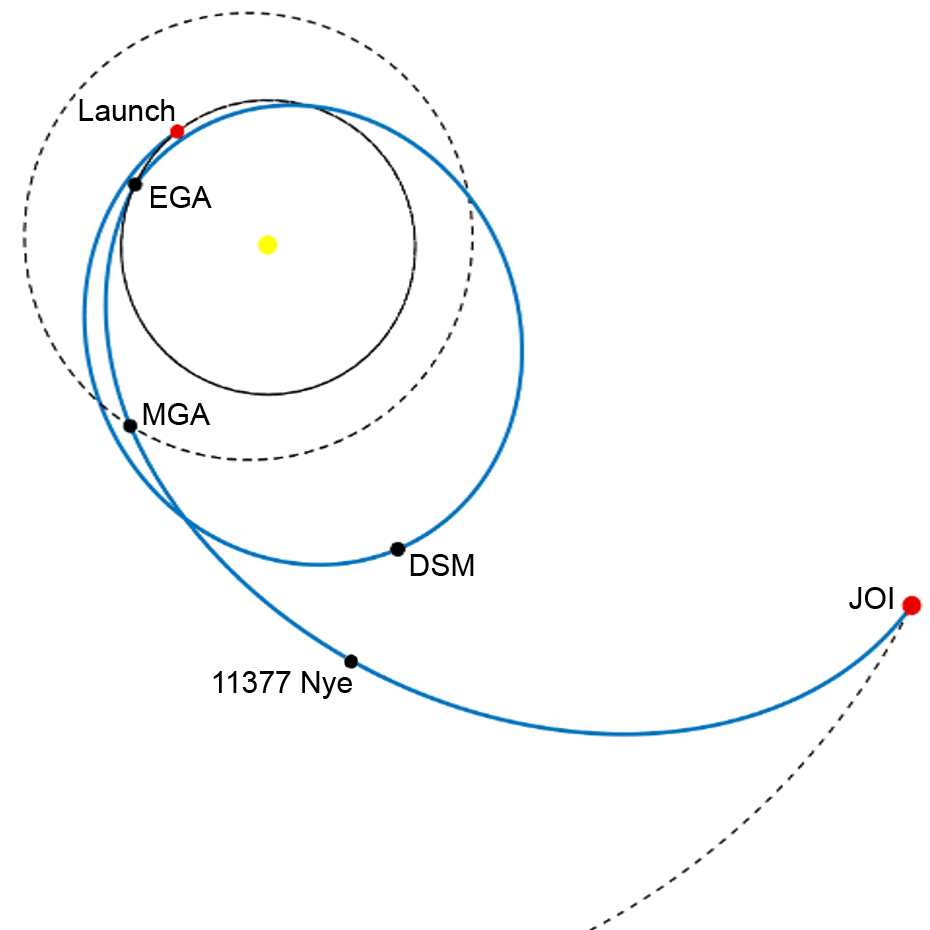 |
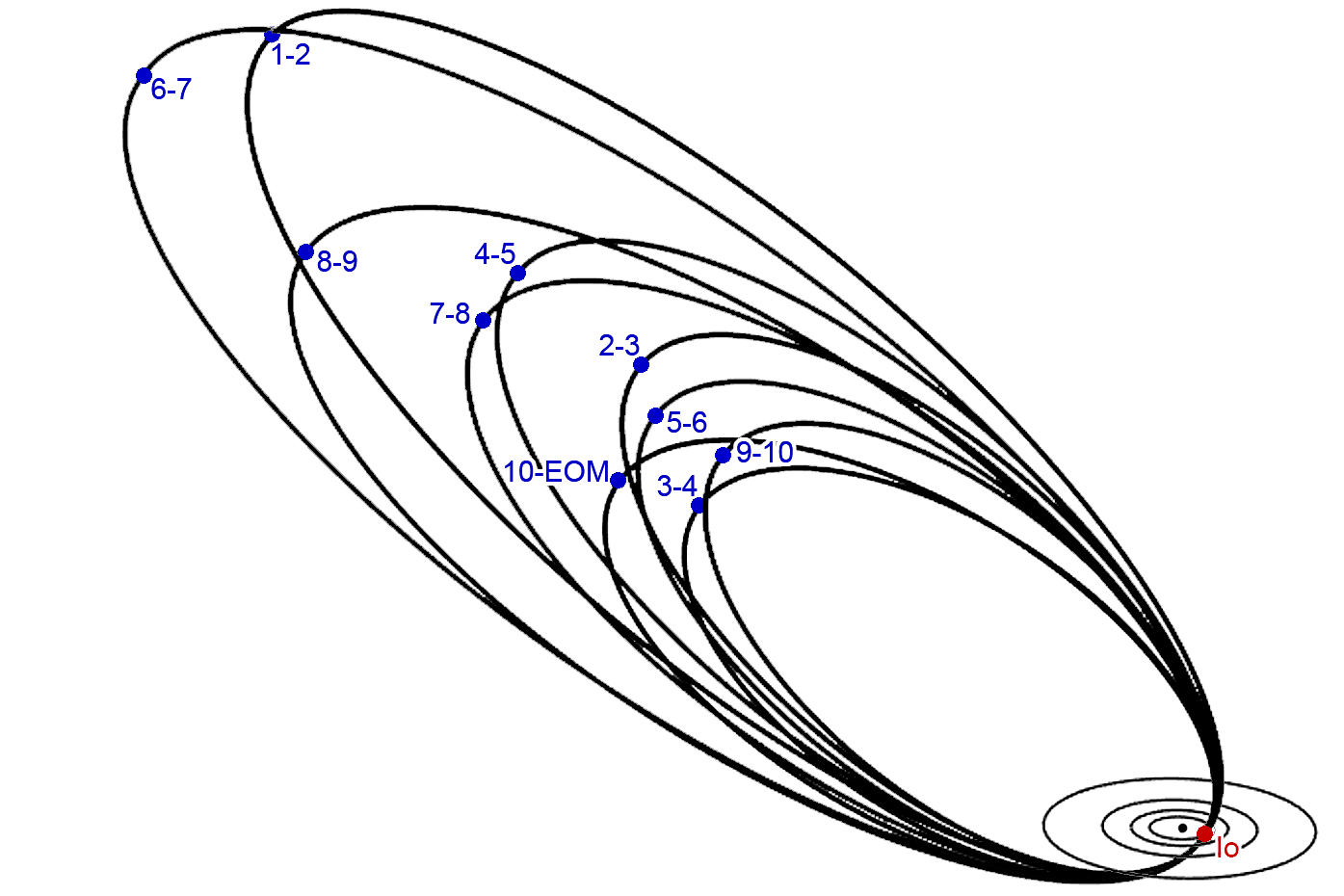 |
Fig. left: Cruise trajectory of IVO for a January 2029 launch and August 2033 arrival at Jupiter. After one orbit about the Sun, a gravity-assist maneuver at Earth and one at Mars give the spacecraft enough boost to reach Jupiter after ∼4.5 years flight time.
Fig. right: Oblique view of IVO’s Jupiter orbit tour. For the prime mission, ten highly inclined Jupiter orbits with ten targeted flybys at Io are planned.
• DSM…Deep Space Maneuver (rocket engine changes the spacecraft’s velocity by more than 1100 km/h); EGA…Earth gravity assist; MGA…Mars gravity assist; 11377 Nye…proposed asteroid flyby; JOI…Jupiter orbit insertion; 1-2, 2-3, etc. … apoapsis passages between two Io flybys; EOM…End-of-mission.
• IVO orbit parameters at Jupiter:
Periapses: ~409650…420640 km (near Io orbit)
Apoapses: ~10…23 million km (up to ~0.4 Jupiter Hill-sphere radii)
Periods: 78 d … 260 d (Io orbit resonances: 1:44 … 1:147)
Eccentricities: 0.921 … 0.965
Inclination: ∼45° (i.e. prograde)
• In the orbit-tour plot, blue dots show the apoapsis positions of IVO. The concentric ellipses at lower right represent the orbits of the Galilean satellites Io (innermost), Europa, Ganymede, and Callisto (outermost). The red dot indicates the Io flyby locations. Jupiter is at the center.
• Most of the time in orbit, IVO will reside north of Jupiter’s equatorial plane “behind” the planet, i.e. Jupiter and the Galilean moons will mainly be visible as crescents (phase angle >110° early, and temporarily >160° later in the mission).
• Mission end is currently planned through Io impact on 06 Jul 2037, but an extended mission may be flown instead.
(4) Spacecraft and instruments
With discard of the IVO mission by NASA in June 2021, the information in this sheet is only of historic relevance.
(4A) Spacecraft
Hexagon shaped: 0.0 × 0.0 m
Main antenna: ∅ = 2.1 m
Dry mass: 760 kg
Wet mass: 1830 kg
Attitude control: Three axis (thrusters and reaction wheels)
Energy source: 3 ROSAs (roll-out solar arrays)
Area: 00 m²
Available energy: ###W
Solar irradiation at Jupiter: 50 W/m² (∼4% of Earth’s)
Data storage: Solid-state recorder (capacity: 80 Gbits)
Data transmission: High-gain antenna (HGA)
>10 kbits/sec to 34-m DSN station in X-band
Manufacturer: JHU/APL; xxx
Launcher: To be determined (prefered option: Falcon Heavy)
Launch location: Kennedy Space Center, Cape Canaveral (Florida)
IVO vehicle code assignment (SPICE):
tbd
(4B) Science Experiments
NAC, TMAP, (SWAC, RUSHeS), DMAG, PIMS, INMS, GS
NAC and TMAP on pivot
(remote sensing) (table)
Instrument FOV IFOV Pixel #colors heritage
NAC; TMAP; TMAP; SWAC; RUSHeS
NAC&TMAP mounted on a pivot
IVO NAC: IFOV = 10µrad => = 2.06″
(Cassini was 2.48″ in 2sum mode)
Other instruments: GS; DMAG; PIMS; INMS
(5) Science objectives
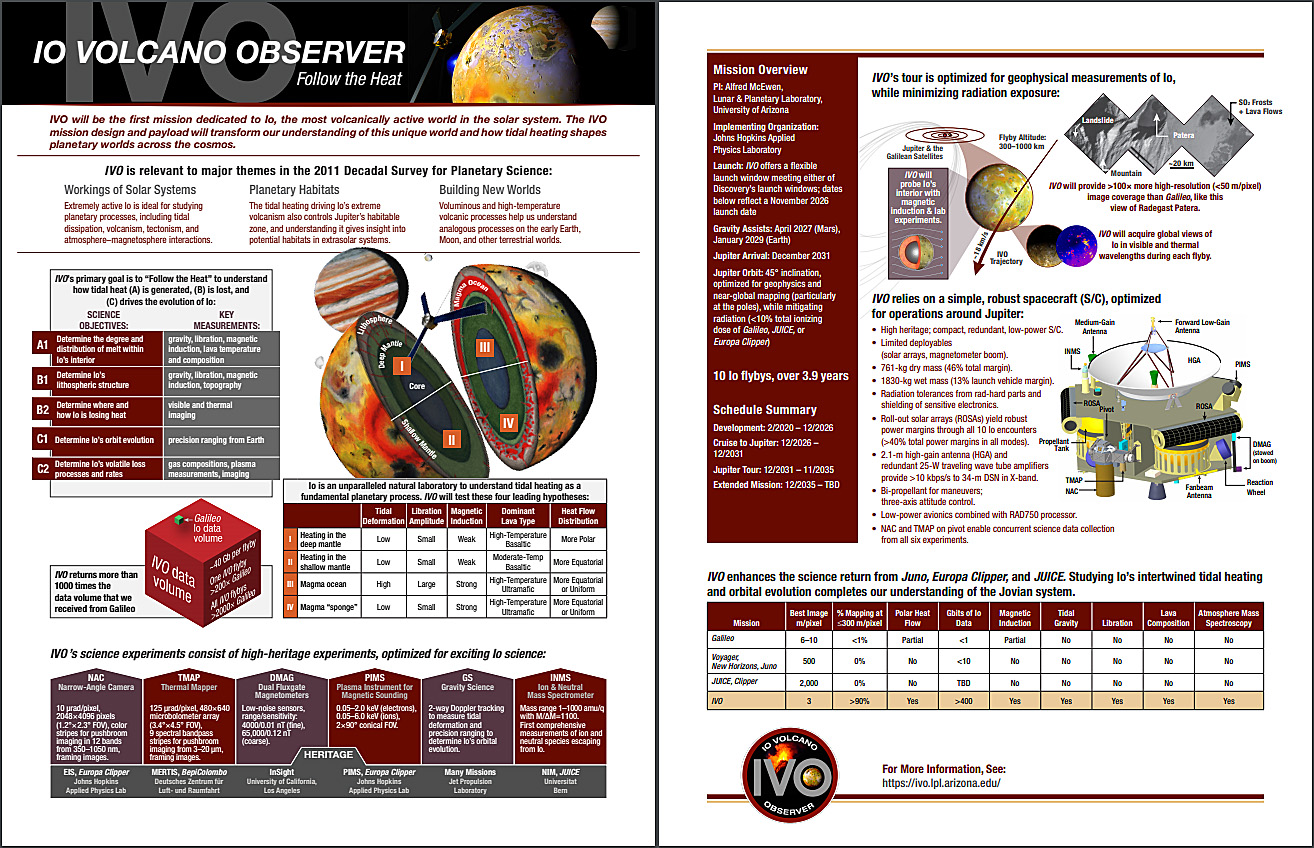 IVO science goals were the thorough investigation of Jovian volcano moon Io.
IVO science goals were the thorough investigation of Jovian volcano moon Io.
Io at a glance:
– SPICE ID: 501
– Mean diameter: 3643.2 ± 1.0 km
– Radii: (1829.4 x 1819.4 x 1815.7) km (from SPICE kernel)
– Orbit semi-major axis: 421700 km
– Orbit eccentricity: 0.0041
– Orbit inclination: 0.05° (to Jupiter’s equator)
– Orbit period: 1 d 18 h 27 min 33.5 s (42.45930686 h)
– Rotation period: synchronous
– Group: Galilean satellites
– Discovery: Jan 1610 by Galileo Galilei at Padua (Italy) (from the balcony of his house in via Vignali (today via Galileo Galilei)); published in Mar 1610 in the Sidereus Nuncius. Io and the other Galilean moons have been independently discovered by Simon Marius at Gunzenhausen (Germany); published in 1614 in his Mundus Iovialis.
Other researcg goals have been:
• Jupiter atmosphere and magnetosphere
• Inner regular moons
• Outer irregular moons
(6) Mission leadership
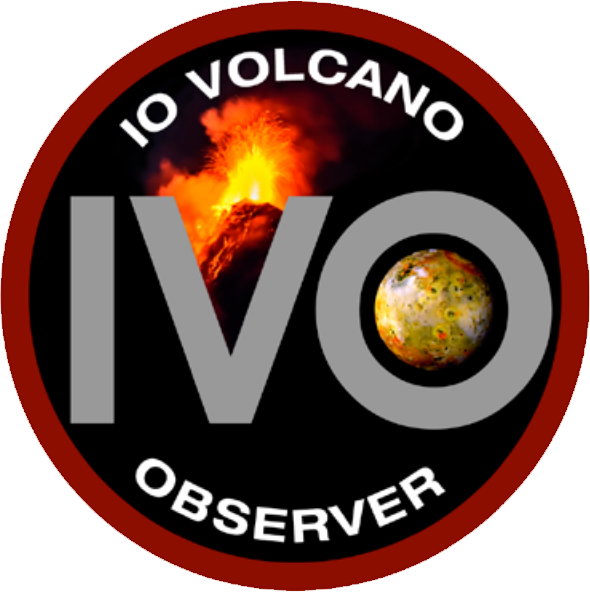 IVO was a Discovery mission proposal from NASA and thus led by a principal investigator (PI), who assembles a team of scientists and engineers. The following scientists and engineers were among the key personnel and institutions:
IVO was a Discovery mission proposal from NASA and thus led by a principal investigator (PI), who assembles a team of scientists and engineers. The following scientists and engineers were among the key personnel and institutions:
PI: Alfred McEwen (UA/LPL)
Co-PI: Laszlo Kestay (USGS)
Project Management: JHU/APL
Instrument/experiment leads:
NAC: Elizabeth Turtle (JHU/APL)
TMAP: Jörn Helbert (DLR)
DMAG: Krishan Khurana (UCLA)
PIMS: Joseph Westlake (JHU/APL)
INMS: Peter Wurz (University of Bern)
Radio Science: Ryan Park (JPL)
SWAC: Daniela DellaGiustina (UA, JHU/APL)
RUSHeS: Walter Harris (UA)
(7) Footage from the project
Fact sheet → pdf file
Poster → jpg file
(8) History/events
• 02 Jun 2021: IVO has not been selected for Phase-B → NASA press release
• 13 Feb 2020: IVO has been selected for Phase-A study
→ NASA press release → NSPIRES release (pdf file) → Univ. Arizona press release → JHU/APL press release
(9) Links, references, acknowledgments
♦ Links outside
Wikipedia — ![]() Io Volcano Observer
Io Volcano Observer ![]() IVO (Raumsonde)
IVO (Raumsonde)
Wikipedia — ![]() Jovian moon Io (moon)
Jovian moon Io (moon) ![]() Jupitermond Io (Mond)
Jupitermond Io (Mond)
Wikipedia — ![]() Galilean moons
Galilean moons ![]() Galileische Monde
Galileische Monde
![]() IVO at University of Arizona/LPL: mission home page
IVO at University of Arizona/LPL: mission home page
![]() IVO/TMAP-Seite am DLR in Berlin
IVO/TMAP-Seite am DLR in Berlin
![]() Abstracts on TMAP: LPSC 2015; LCPM Berlin 2015
Abstracts on TMAP: LPSC 2015; LCPM Berlin 2015
A very similar instrument flying with BepiColombo to Mercury is ![]() MERTIS;
MERTIS; ![]() MERTIS
MERTIS
NASA Discovery Programme 2019 Announcement of Opportunity Website
◊ Io images from other spacecraft (by Jason Perry):
● 1979: Voyager Images of Io (amazing stuff from pre-CCD era)
● 1996-2001: Galileo Images of Io (including high resolution data from targeted flybys)
● 2007: New Horizons Images of Io (low resolution, but amazing eruption plumes) (plus an animated gif)
● 2017-2024: Juno images of Io (mainly low resolution of hot spots)
-Planned close Io flybys by Juno: perijove-57 (30 Dec 2023); perijove-58 (03 Feb 2024); both as animations
♦ References (alphabet-ordered)
| Helbert, J., Maturilli, A., Ferrari, S., Breuer, D., Spohn, T. (2015): Studying Io’s Volcanic History Using Thermal Infrared Measurements. 46th LPSC, abstract 1906, LPI, Houston, TX. | |
| Keszthelyi, L.P., McEwen, A.S. , Phillips, C.B., Milazzo, M., Geissler, P., Turtle, E.P., Radebaugh, J., Williams, D.A., Simonelli, D.P., Breneman, H.H., Klaasen, K.P., Levanas, G., Denk, T., Galileo SSI Team (2001): Imaging of volcanic activity on Jupiter’s moon Io by Galileo during the Galileo Europa Mission and the Galileo Millennium Mission. J. Geophys. Res. (Planets) 106, E12, 33,025-33,052. | |
| Keszthelyi, L.P., Turtle, E.P., McEwen, A.S., Simonelli, D.P., Geissler, P., Williams, D.A., Milazzo, M., Radebaugh, J., Jaeger, W.L., Klaasen, K.P., Breneman, H.H., Denk, T., Head, J.W., Galileo SSI Team (2002): Galileo SSI observation of Io during orbits C30-I33. 33rd LPSC, abstract 1454, LPI, Houston, TX. | |
| McEwen, A.S., de Kleer, K., Park, R. (2019): Does Io have a magma ocean?, Eos 100, https://doi.org/10.1029/2019EO135617. | |
| McEwen, A.S., Turtle, E., Kestay, L., Khurana, K., Westlake, J., Wurz, P., Helbert, J., Park, R., Kirby, K., Haapala-Chalk, A., Breuer, D., Davies, A.G., Hamilton, C.W., Horst, S., Jia, X., Jozwiak, L., Keane, J.T., de Kleer, K., Lainey, V., Mandt, K., Matsuyama, I., Mousis, O., Nimmo, F., Paranicas, C., Perry, J., Pommier, A., Radebaugh, J., Spencer, J., Sutton, S., Thomas, N. (2019): The Io Volcano Observer (IVO): Follow the Heat. 50th LPSC, abstract 1316, LPI, Houston, TX. | |
| Turtle, E.P., Keszthelyi, L.P., McEwen, A.S., Radebaugh, J., Milazzo, M., Simonelli, D.P., Geissler, P., Williams, D.A., Perry, J., Jaeger, W.L., Klaasen, K.P., Breneman, H.H., Denk, T., Phillips, C.B., Galileo SSI Team (2004): The Final Galileo SSI Observations of Io: Orbits G28-I33. Icarus 169, 3-28. |
♦ Acknowledgments
I am very grateful to the following institutions and persons:
• DLR (Deutsches Zentrum für Luft- und Raumfahrt) in Berlin-Adlershof — they gave me leave to work with Cassini/Saturn at Freie Universität (FU) Berlin for 16 years, and now (since January 2020) employ me again for working in the Jupiter system.
© Tilmann Denk (2023)

